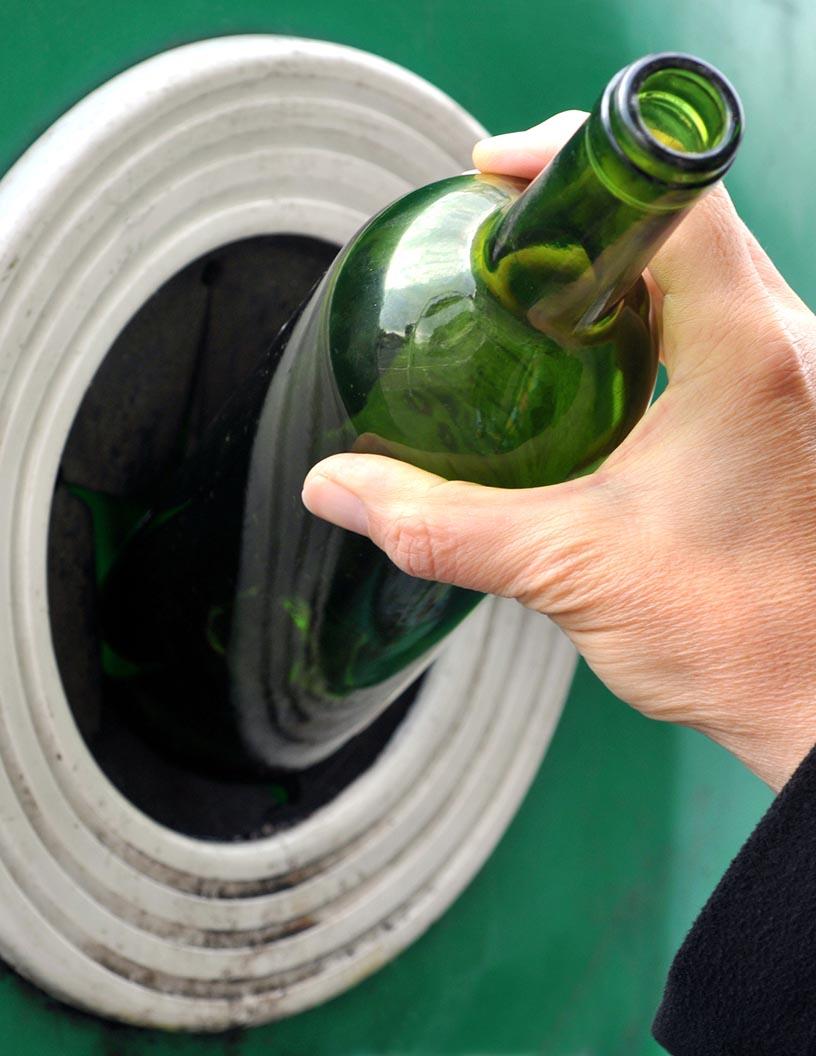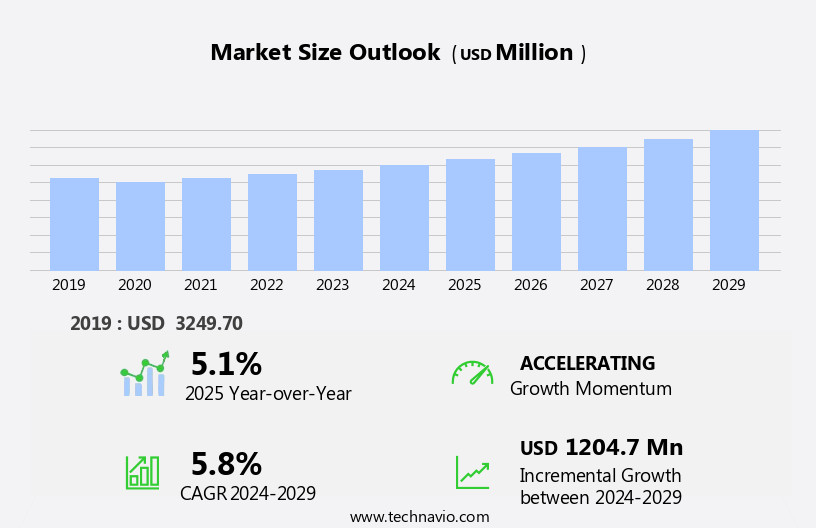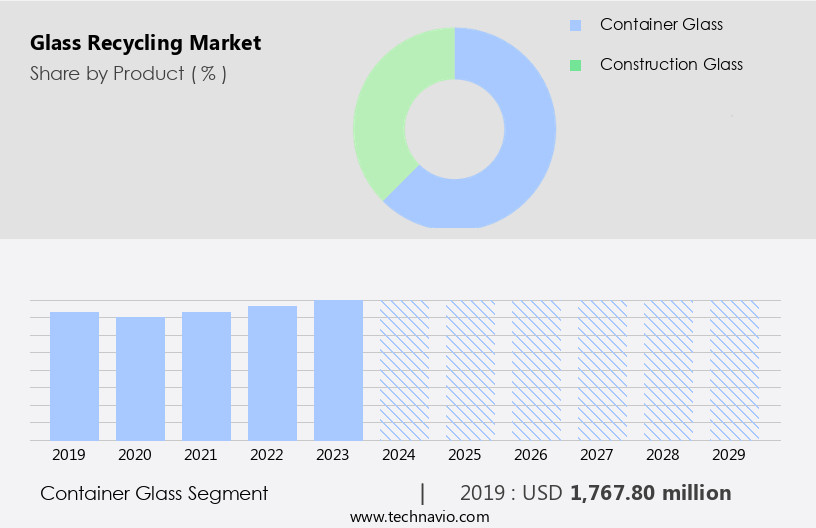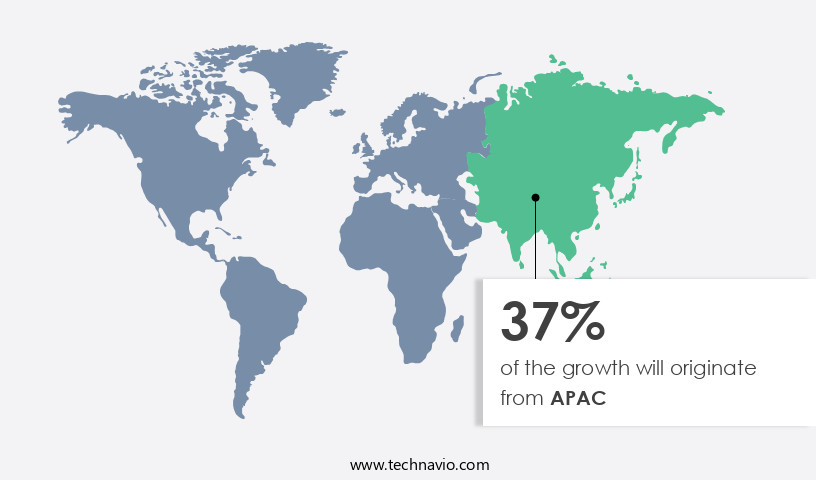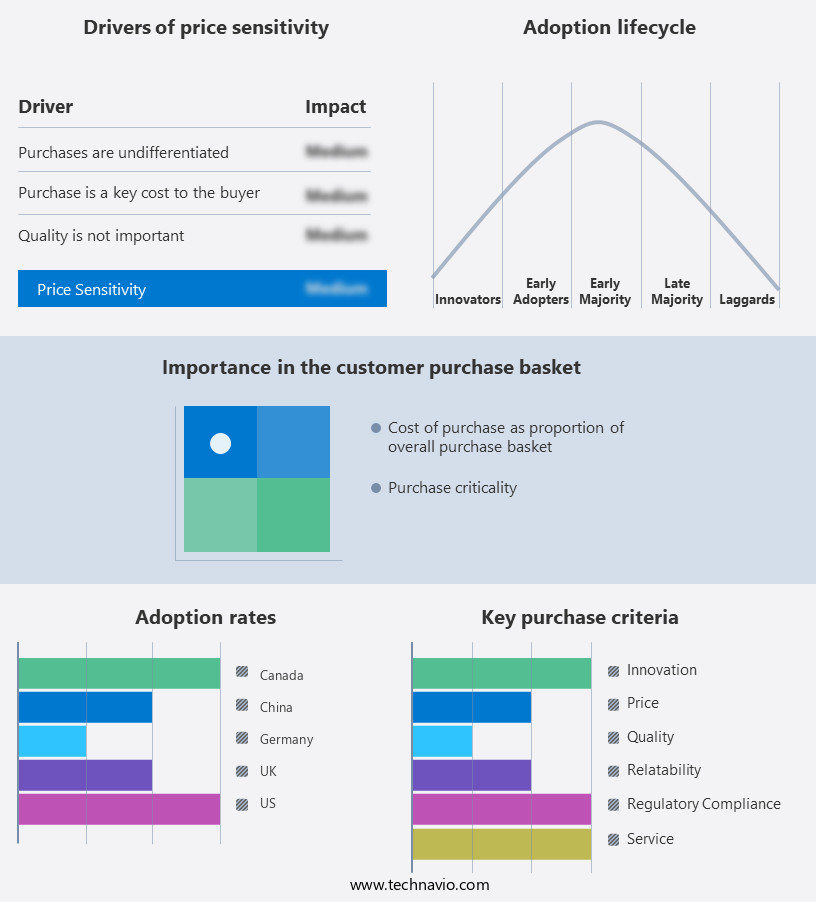Glass Recycling Market Size 2025-2029
The glass recycling market size is forecast to increase by USD 1.2 billion, at a CAGR of 5.8% between 2024 and 2029.
- The market is driven by the growing economic benefits of glass recycling, particularly in North America where the use of glass cullet has become increasingly prevalent. This trend is attributed to the cost savings and environmental advantages of recycling glass, including energy conservation and reduced raw material costs. However, the market faces significant challenges due to the complexities of the glass recycling supply chain.
- The high operating costs associated with this intricate network can hinder market growth and profitability for industry players. Effective management of this supply chain, through optimization of logistics and transportation, could represent a key opportunity for companies to mitigate these costs and capitalize on the expanding market demand for glass recycling solutions.
What will be the Size of the Glass Recycling Market during the forecast period?
Explore in-depth regional segment analysis with market size data - historical 2019-2023 and forecasts 2025-2029 - in the full report.
Request Free Sample
The market continues to evolve, driven by the need for waste management and landfill diversion, as well as the growing demand for sustainable material solutions across various sectors. Technological innovation plays a pivotal role in this dynamic market, with advancements in magnetic separation, glass polishing, and NIR sorting enabling more efficient and effective processing of glass containers. Process optimization is a key focus, with an emphasis on reducing glass breakage and minimizing environmental impact through life cycle assessment. Glass powder and recycled glass are gaining traction as secondary raw materials, while glass aggregates and fiberglass offer opportunities for aggregate replacement in construction materials.
The circular economy is a driving force, with the production of value-added products from recycled glass, such as insulation materials and color-sorted glass fragments. The market for architectural glass, automotive glass, and insulating glass is expanding, as is the use of glass in road construction and window glass. Material flow analysis and material balance are essential for optimizing glass recycling plants, ensuring economic viability and adherence to industry standards. Glass coating, glass annealing, and glass cutting are integral parts of the glass processing chain, with quality control and color sorting ensuring consistent output. Tempered glass, plate glass, and sheet glass are in high demand, with glass melting and glass cullet essential for their production.
The market for specialized glass, such as reinforced concrete and energy-efficient glass, is growing, as is the demand for glass jars and container glass. The glass recycling industry is constantly evolving, with a focus on reducing waste, improving efficiency, and minimizing environmental impact. From glass annealing to glass forming, and from glass cleaning to glass fragmentation, the market is a dynamic and ever-changing landscape.
How is this Glass Recycling Industry segmented?
The glass recycling industry research report provides comprehensive data (region-wise segment analysis), with forecasts and estimates in "USD million" for the period 2025-2029, as well as historical data from 2019-2023 for the following segments.
- Product
- Container glass
- Construction glass
- Application
- Alcohol industry
- Food and beverage industry
- Construction industry
- Others
- End-User
- Packaging
- Construction
- Automotive
- Electronics
- Collection Method
- Curbside Collection
- Drop-Off Centers
- Commercial Collection
- Geography
- North America
- US
- Canada
- Europe
- France
- Germany
- Italy
- UK
- APAC
- China
- India
- Japan
- South Korea
- Rest of World (ROW)
- North America
By Product Insights
The container glass segment is estimated to witness significant growth during the forecast period.
The container glass market, encompassing bottles and jars utilized in the food and beverage, pharmaceutical, and cosmetic industries, experiences significant demand due to its prevalence as a key packaging solution in the thriving global food and beverage sector, projected to reach approximately USD15 trillion by 2026. Major contributors to this industry include the US, China, and Germany. In response to growing environmental concerns, numerous food and beverage manufacturers are implementing recycling initiatives for their packaging waste. This trend is particularly prominent in container glass, which undergoes various processes such as magnetic separation, glass polishing, and sorting systems to ensure high-quality recycled glass cullet for manufacturing new glass containers and bottles.
Technological innovations, including NIR sorting and material flow analysis, contribute to the efficient and effective recycling process. Recycled glass is not only economically viable but also reduces waste and carbon footprint, making it an essential component in the circular economy. Additionally, recycled glass finds applications in various industries, including automotive glass, architectural glass, insulation materials, and construction materials, further increasing its market value. The container glass industry adheres to stringent industry standards for quality control and material balance, ensuring the production of superior glass products.
The Container glass segment was valued at USD 1.77 billion in 2019 and showed a gradual increase during the forecast period.
Regional Analysis
APAC is estimated to contribute 37% to the growth of the global market during the forecast period.Technavio's analysts have elaborately explained the regional trends and drivers that shape the market during the forecast period.
Europe leads The market, with recycling rates increasing from 66 percent in 2013 to 74 percent by 2023. This trend is set to continue, driven by government initiatives. For instance, the UK government's Deposit Return Scheme (DRS), which includes glass bottles, was proposed in 2019 and aims to increase recycling rates of single-use containers to at least 90% within three years of implementation. This commitment was reaffirmed in April 2024. Process optimization in glass recycling plants utilizes technological innovations such as magnetic separation, glass polishing, and sorting systems. These advancements enhance material balance, reduce waste, and ensure quality control.
Glass recycling extends beyond container glass to architectural, automotive, and specialty glass applications. The circular economy approach promotes the use of recycled glass in insulation materials, reinforced concrete, and construction materials. Glass annealing, coating, and forming are essential processes in glass recycling, ensuring economic viability and meeting industry standards. The environmental impact of glass recycling is significant, as it reduces carbon footprint, landfill diversion, and raw material substitution. Glass powder and aggregates are valuable by-products of the recycling process, contributing to the circular economy. The glass industry continues to innovate, with developments in glass melting, glass cullet, and glass crushing.
Recycled glass is used in various applications, including energy efficiency, insulating glass, and value-added products. The market's future lies in continued process optimization, waste reduction, and the integration of glass recycling into various industries.
Market Dynamics
Our researchers analyzed the data with 2024 as the base year, along with the key drivers, trends, and challenges. A holistic analysis of drivers will help companies refine their marketing strategies to gain a competitive advantage.
What are the key market drivers leading to the rise in the adoption of Glass Recycling Industry?
- The economic advantages of glass recycling serve as the primary motivator for the market's growth.
- Glass recycling plays a crucial role in preserving natural resources and reducing landfill waste. By incorporating approximately 10% of recycled glass cullet into the production process, energy consumption is decreased by around 3%, resulting in a significant reduction of carbon dioxide emissions. This process offers various economic advantages, including the conservation of raw materials. The use of recycled glass in glass production saves around 10% of natural resources such as sand, soda ash, limestone, and feldspar. Moreover, the extended furnace life is another economic benefit, as recycled glass makes the furnace less corrosive and lowers the melting temperature. Technological innovations, like magnetic separation and glass polishing, have enhanced the glass recycling process's efficiency and quality.
- Glass recycling also extends to various applications, such as architectural glass, automotive glass, glass annealing, and glass powder for road construction. The environmental impact of glass recycling is substantial, making it a viable economic solution for businesses and industries. Colored glass and glass breakage can also be recycled, ensuring a closed-loop system and minimizing waste.
What are the market trends shaping the Glass Recycling Industry?
- The use of glass cullet is gaining popularity as the next market trend in North America. This sustainable practice involves the reutilization of recycled glass in the production of new glass products.
- The market in North America has gained significant traction due to increasing waste management initiatives and the emphasis on landfill diversion. The use of recycled glass in various applications, such as glass containers and decorative glass, has surged. According to recent research, the recycled glass cullet usage in the glass container industry in North America increased by 8% between 2013 and 2023. This trend is driven by the growing demand for eco-friendly products, including green glass, which consists of 90%-95% recycled materials. Moreover, many glass manufacturers are prioritizing sustainability in their business operations. For instance, Owens-Illinois Inc., a leading container glass manufacturer, aims to use 60% recycled glass cullet in their manufacturing processes by 2025.
- This commitment to using recycled glass not only reduces the carbon footprint but also contributes to the circular economy. The glass industry's material flow analysis involves the sorting and processing of various types of glass, including window glass, laminated glass, tempered glass, glass jars, and bottles. The sorting systems ensure that the glass is fragmented appropriately for further processing into glass aggregates or reused as raw materials. Additionally, glass coating and material balance are crucial aspects of the glass recycling process. Overall, the market in North America is poised for continued growth as more companies adopt sustainable practices and consumers demand eco-friendly products.
What challenges does the Glass Recycling Industry face during its growth?
- The intricate supply chains in the industry significantly increase operating costs, posing a substantial challenge to its growth.
- The market involves a intricate supply chain with numerous intermediaries, leading to increased operating costs for companies. The process begins with the collection of glass recyclables from various sources, including municipal solid waste, consumer and industrial waste, and construction and demolition wastes. These recyclables are delivered to material recovery facilities for further processing. At the facility, different types of recyclable glass, such as container and construction glass, are separated and sent to glass recycling companies. The recyclable glass undergoes additional sorting by color to ensure quality control. The sorted glass is then processed into various forms, such as aggregate replacement, insulation materials, glass fibers, and value-added products.
- The recycled glass finds extensive applications in various industries, including building construction, where it is used as reinforced concrete, glass cutting, and glass melting raw material. The glass cullet, a key component of glass processing, is a valuable construction material that adheres to industry standards. The glass recycling process plays a significant role in waste reduction and sustainability efforts by transforming waste glass into valuable resources.
Exclusive Customer Landscape
The glass recycling market forecasting report includes the adoption lifecycle of the market, covering from the innovator's stage to the laggard's stage. It focuses on adoption rates in different regions based on penetration. Furthermore, the glass recycling market report also includes key purchase criteria and drivers of price sensitivity to help companies evaluate and develop their market growth analysis strategies.
Customer Landscape
Key Companies & Market Insights
Companies are implementing various strategies, such as strategic alliances, glass recycling market forecast, partnerships, mergers and acquisitions, geographical expansion, and product/service launches, to enhance their presence in the industry.
Biffa Plc - This company specializes in glass recycling solutions, transforming waste glass into new single-color glass or utilizing it as aggregate in construction. Through innovative processes, they effectively reduce environmental impact while maintaining high-quality outcomes.
The industry research and growth report includes detailed analyses of the competitive landscape of the market and information about key companies, including:
- Biffa Plc
- Bottleman Recycling Services Ltd.
- Bywaters
- Dlubak Glass Co.
- FCC Environment (UK) Ltd.
- Gaskell Waste Services Ltd.
- Glass Recycling UK Ltd.
- Glassco Recycling Ltd.
- Momentum Recycling LLC
- Prism Glass Recycling LLC
- Ripple Glass LLC
- Rubicon Technologies Inc.
- Stericycle Inc.
- Strategic Materials Inc.
- SWARCO AG
- TerraCycle Inc.
- Vetropack Group
- Vitro Minerals Inc.
- Wiegand Glas Holding GmbH
Qualitative and quantitative analysis of companies has been conducted to help clients understand the wider business environment as well as the strengths and weaknesses of key industry players. Data is qualitatively analyzed to categorize companies as pure play, category-focused, industry-focused, and diversified; it is quantitatively analyzed to categorize companies as dominant, leading, strong, tentative, and weak.
Recent Development and News in Glass Recycling Market
- In January 2024, leading glass recycling company, Vitro, announced the launch of its new recycled glass plant in the United States, expanding its production capacity by 250,000 tons annually. This strategic expansion aimed to meet the growing demand for recycled glass in the North American market (Vitro press release, 2024).
- In March 2024, Owens-Illinois, Inc. (O-I), the world's largest glass container manufacturer, and Hewlett Packard Enterprise (HPE), a leading technology company, formed a partnership to explore the use of recycled glass in HPE's data centers. This collaboration aimed to reduce the environmental impact of data centers and promote circular economy practices (O-I press release, 2024).
- In May 2024, Nippon Sheet Glass (NSG), a global glass manufacturer, completed the acquisition of Pilkington's float glass business from NSG Group. This strategic move strengthened NSG's position in the European glass market and expanded its recycled glass production capabilities (NSG press release, 2024).
- In April 2025, the European Union (EU) passed the Circular Economy Action Plan, which included ambitious targets for glass recycling. The plan aimed to increase glass recycling rates to 90% by 2030, driving significant growth in the European the market (European Commission press release, 2025).
Research Analyst Overview
- The market is experiencing dynamic shifts, driven by various factors. Deposit return schemes have significantly influenced consumer behavior, increasing the collection of used glass containers. Safety regulations and glass coating technologies ensure the production of high-quality recycled glass, aligning with performance indicators and quality assurance standards. Public awareness campaigns and sensor-based sorting systems have improved the sorting process, ensuring the separation of different glass types. Investment opportunities abound in areas such as glass lamination processes, beneficiation, and storage facilities. AI-powered sorting and glass tempering techniques are revolutionizing the industry, enhancing efficiency and productivity. Environmental regulations and sustainability metrics are key policy implications, pushing businesses towards closed-loop recycling and decolorization processes.
- Glass sterilization and sterilization technologies are essential for maintaining hygiene and safety standards. Economic incentives and product stewardship initiatives are driving innovation in the sector. Transportation logistics and data analytics are critical business models, optimizing the collection and transportation of glass waste. Big data and automated sorting technologies are transforming the industry, enabling real-time monitoring and analysis of market trends. Blockchain technology is gaining traction, offering transparency and traceability in the glass recycling supply chain. Overall, the market is evolving, presenting numerous opportunities for businesses to innovate and grow.
Dive into Technavio's robust research methodology, blending expert interviews, extensive data synthesis, and validated models for unparalleled Glass Recycling Market insights. See full methodology.
|
Market Scope |
|
|
Report Coverage |
Details |
|
Page number |
199 |
|
Base year |
2024 |
|
Historic period |
2019-2023 |
|
Forecast period |
2025-2029 |
|
Growth momentum & CAGR |
Accelerate at a CAGR of 5.8% |
|
Market growth 2025-2029 |
USD 1204.7 million |
|
Market structure |
Fragmented |
|
YoY growth 2024-2025(%) |
5.1 |
|
Key countries |
US, UK, China, Canada, Germany, Japan, India, France, Italy, and South Korea |
|
Competitive landscape |
Leading Companies, Market Positioning of Companies, Competitive Strategies, and Industry Risks |
What are the Key Data Covered in this Glass Recycling Market Research and Growth Report?
- CAGR of the Glass Recycling industry during the forecast period
- Detailed information on factors that will drive the growth and forecasting between 2025 and 2029
- Precise estimation of the size of the market and its contribution of the industry in focus to the parent market
- Accurate predictions about upcoming growth and trends and changes in consumer behaviour
- Growth of the market across Europe, APAC, North America, Middle East and Africa, and South America
- Thorough analysis of the market's competitive landscape and detailed information about companies
- Comprehensive analysis of factors that will challenge the glass recycling market growth of industry companies
We can help! Our analysts can customize this glass recycling market research report to meet your requirements.
